
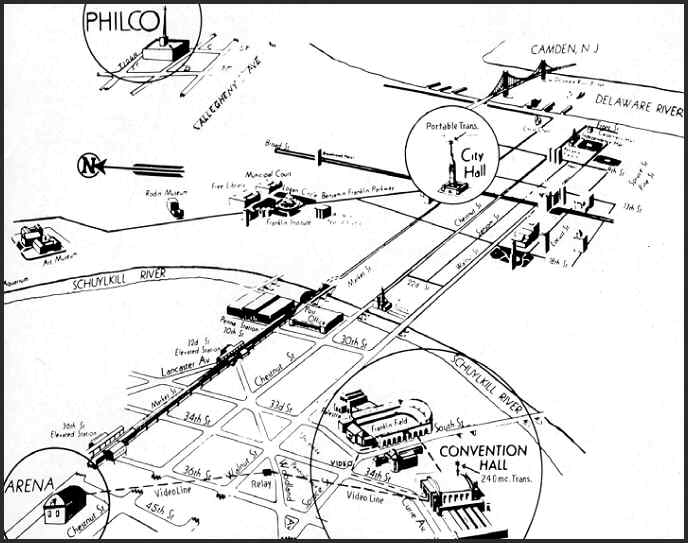
Map of transmission
Convention Hall to Philco Plant
(map created in 1941)
When we think of microwaving, we usually think of it as a quick way to heat up food. However, microwave transmission of television signals has been around since the earliest days of TV. Here's a good example right here in our own back yard:
Philco and Channel 3 in Philadelphia (then W3XE) did the first local television coverage of a political convention. The year was 1940. In June, W3XE (later WPTZ and now known as KYW-TV) televised the entire National Convention of the Republican Party.
There were a thousand delegates and an equal amount of alternates. The event was held right here in Philadelphia (1940 population was 1,931,334 people) and channel 3, owned by Philco, broadcast a total of 62 hours of coverage (it was all live). It was the first television station in the history of the world to televise local, non-network reporting of a national political convention. They did NOT carry the NBC-TV network coverage (carried live over NBC's New York City station and GE's station in Schenectady via coaxial cable).
For Philadelphia viewers, the route was totally different. It went from the Convention Center direct to the Philco Plant at C & Tioga Streets in Philadelphia via what was considered a microwave transmission (240 MHz) in that era. The 15,000-watt relay station had the call letters of W3XP. Philco used no land lines in their transmission whatsoever. W3XE's 10,000-watt signal covered a 25-mile radius from its 230-foot high transmitting tower located in 1940 on the top of the Philco plant.
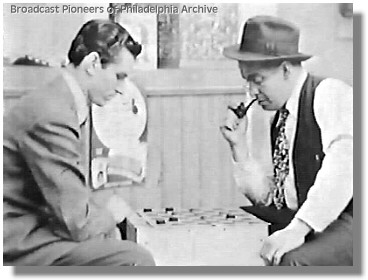
Scene from "Last Year's Nest"
(Left to right) Leonard Valenta and unidentified person
WPTZ, Channel 3
1942
Since 1942, WPTZ was broadcasting the "NBC Television Network," which consisted of three stations, WNBT in the Big Apple, WPTZ in the Big Scrapple and WRGB in upstate New York. Programming was almost non-existent. The above photo is from the TV show "Last Year's Nest" and originated live from WPTZ and was fed to the NBC Television Network which consisted of three stations, Philly, NYC and Schenectady. Shortly after the production of "Last Year's Nest," Channel 3 lost its studio (which was in the Philco plant). Why? The space was needed for war-time production.
Late in December of 1943, Philco applied for two TV licenses in addition to WPTZ, one in NYC (proposal called for the station to be on Channel 9) and the other in Washington, DC (with the proposal calling for the station to be on Channel 4). (The Philco DC station was on the air only as an experimental station in early 1945 with the application for permanent allocation withdrawn in 1946.) NBC also asked for two stations, one in Philadelphia to be affiliated with KYW Radio (which was then the NBC Radio affiliate) and the other, an NBC owned and operated station in the nation's capitol. NBC never got the Philly station but eventually got the Philco frequency when Philco withdrew its application.
In 1943, Philco was thinking of the future. David B. Smith, the director of research for the company said that over the next few years, New York, Philadelphia, Washington and some other Atlantic seaboard cities would have a wide choice of programming. Philco at that time was planning their own television network.
A year later, In a letter to Philco stockholders dated June 12, 1944, the President of Philco, Dr. John Ballantyne wrote:
When television standards have been established by the FCC and the material situation eases to the point where new equipment can be produced, television promises to grow rapidly in public esteem and popularity. ...Philco plans to be fully ready to participate in and contribute to these developments.
On May 25, 1944, there was the official dedication of the "permanent" television relay link between NYC and Philly. It replaced previous experimental facilities. The link (located at Mount Rose, near Princeton, NJ) sent WNBT (NBC) programming on Monday evenings to Philadelphia and a different link (owned by GE) sent the signal to Schenectady. Of the new Philco link, Ballantyne said:
The new television relay, developed by Philco engineers, is capable of providing dependable, high quality service at all times and under all atmospheric conditions. It is entirely possible that similar links, which can be constructed at a cost about $15,000 each, located approximately 60 miles apart, may form the basis for a nationwide television system in the post-war period.
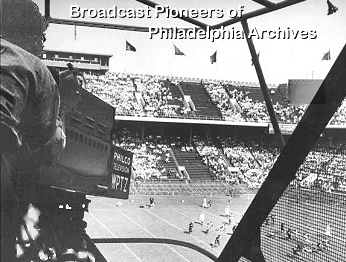
Early Telecast of Penn football
WPTZ, Channel 3
circa 1944
While Ballantyne hoped for high quality service regardless of weather, there were still some "bugs" to be ironed out. On October 7th of that same year, Philco fed NYC and Schenectady a test broadcast of the Duke University vs. the University of Pennsylvania football game live from Philadelphia. By the time it reached NYC using the new Philco relay unit, the picture was partially washed out. However, when it went to upstate New York using GE's relay, the picture quality was terrible, described as "an unpretty collection of blotches." There was never an official explanation but off the record, the story was that during transmission, there was inference from external radio signals. The next game to try would have been a week later, but everyone concerned decided to cancel the telecast. Later, the problems were straightened out.
In March of 1945, Ballantyne stated:
We believe that television has now progressed to the point where it is ready to proceed commercially at the end of the war and provide satisfactory service for the public. ...Philco believe that these (television) channels will permit several hundred stations to on on the air over the next several years and give a large part of the public, regular television program service. Many sections of the country will have the benefit of programs from several stations. The commission's action can therefore be the basis for a large post-war industry and provide employment and job opportunities for a great many people.
By the end of the Second World War, there were 7 television stations on the air. They were:
WNBT (now WNBC-TV), New York (owned by NBC)
WCBW (now WCBS-TV), New York (owned by CBS)
WABD (now WNYW), New York (owned by DuMont)
WRGB, Schenectady, NY (owned by General Electric)
WPTZ (now KYW-TV), Philadelphia (owned by Philco)
WBKB, Chicago, (owned by Balaban & Katz)
W6XAO, Los Angeles (now KCBS) (owned by Don Lee)
Two additional stations (one in Chicago and one in LA) were licensed by didn't make it on the air. Things were pretty much on hold during the war with stations sometimes only carrying the four hours weekly requirement of the FCC in order to keep the license alive.
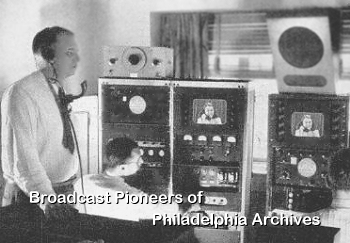
Three Philco engineers
The Control Room of the Philco Studio
Statler Hotel, Washington, DC
Tuesday, April 17, 1945
On June 6, 1951, former Broadcast Pioneers Board Member Harold Pannepacker, who worked at Channel 3 for four decades said:
April 17, 1945 saw WPTZ succeed in bringing the first television program ever televised from Washington, D.C. to Philadelphia. Paul A. Porter, the chairman of the FCC, Dr. Karl T. Compton, president of the Massachusetts Institute of Technology and chairman of the Research Board for National Security, and John Ballantyne, president of the Philco Corporation, participated in the history making program. A multiple relay television network developed by Philco was employed in making the event possible, quite an accomplishment at that time.
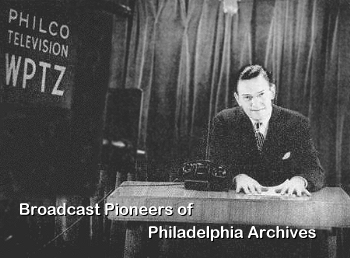
FCC Chairman Paul Aldermandt Porter
Statler Hotel, Washington, DC
Tuesday, April 17, 1945
Paul A. Porter, the Chairman of the Federal Communication Commission in 1945 said that this broadcast was the first telecast that ever took place between Washington, DC and Philadelphia. He congratulated the Philco company and its engineers for making this "a distinguished first in pioneering in this vital aspect of television." He also said:
...(television) will grow into a giant, capable of serving us in many ways which we do not now even comprehend. ...(television) can hasten the process of re-construction (of Germany and) ...can be democracy's greatest hand-maiden by bringing the whole picture of our political, social, economic and cultural life to the eyes as well as the ears.
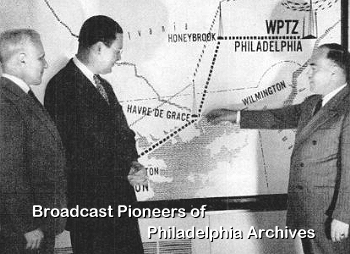
(Left to right) Karl T. Compton, Paul A. Porter and Philco President John Ballantyne
Statler Hotel, Washington, DC
Tuesday, April 17, 1945
At the time, Philco released this statement:
Just as U.S. Highway 1 led to the construction of a road system that linked all America, this Philco television highway along the same route, points the way to a nation-wide network which will bring thrilling television programs to homes from coast to coast. ...(This is) television's first inter-city microwave network, designed by Philco engineers and built by Philco to make television commercially as well as technically an accomplished fact. ...Naturally, Philco, the pioneer in multiple-link television feels these programs to come will be viewed with special brilliance and clarity in those homes equipped with post-war Philco television receivers.
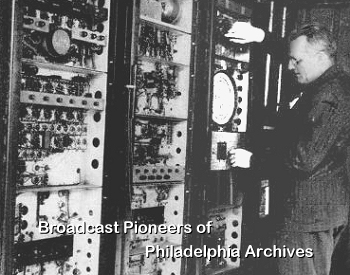
Philco engineer operating the signal generator
Tuesday, April 17, 1945
Between the Nation's Capitol and the City of Brotherly Love, there were two relay stations. Moving north from DC, the first relay was at Havre de Grace, Maryland (about 75 miles from Washington) and then to Honey Brook, PA (about 85 miles from the Maryland relay and just north of Coatesville) and then on another 80 miles to Philadelphia.
On May 28, 1945, the Federal Communications Commission granted new construction permits to Philco for additional television relay stations between Washington and Philadelphia. They also authorized power increased from 15 to 40 watts for the already existing relays. The plan also included linking Philadelphia to New York City with a new system.

Mary Gay and and Dr. John Ballantyne, President of Philco
Statler Hotel, Washington, DC
Tuesday, April 17, 1945
Monica Dalton, a visitor to our website, sent us a beautiful scan of her mother on WPTZ in 1945. Monica said:
My mother, Mary Gay, was the White House Correspondent for Newsweek Magazine during the Truman Administration. She passed away on October 23, 2009 at 95. I have been doing research on her many
accomplishments.One of them is being on the first TV broadcast between Washington, DC and Philadelphia. I have the photograph of WPTZ, Philco, and a gentleman sitting next to her. Mary is on the phone. She had told me the
story many times, being on that first broadcast.
Monica Dalton send us these paragraphs from Mary Gay's unpublished book:
Telecast to Philadelphia, April 17, 1945. Shortly after President Roosevelt's death, a broadcast was scheduled between Washington and Philadelphia. For the few households who were lucky enough to have a television set, they could watch broadcasts which originated from their local area. So now with this city-to-city telecast it was a new and exciting stretch for television beyond city borders.
So now, I was sitting with the president of Philco, Dr. John Ballantyne and we would try to connect to Philco's Philadelphia station, WPTZ in a station-to-station relay. It was very exciting to have the folks in Philadelphia see and talk with us from 150 miles away. I can even remember what I wore on this momentous occasion. I had a purple, harem-type skirt with a white laced blouse. The broadcast was kind of crude, the Philadelphia people even commented on my hair. It didn't matter that my skirt was purple because they could not see anything in color, just black and white.
Washington had an experimental station on the top of the Statler Hotel, the tallest building available for this station (which wasn't very high since Washington didn't have any tall buildings). My previous experience with television was with Washington's Dumont (experimental TV) station on 13th Street. Vera Clay from Newsweek and I would record the news for the week for the local Washington viewers, Newsweek's version of the news.
This regular monthly column is written and researched by Gerry Wilkinson |
![]()
From the official archives of the Broadcast Pioneers of Philadelphia
1941 relay map originally donated by Norm Gagnon and the GGN Website
Other photos from the KYW-TV Archive and from member Bill Bransome
Bottom photo originally donated by Monica Dalton
© 2011, Broadcast Pioneers of Philadelphia
All Rights Reserved
The e-mail address of the Broadcast Pioneers of Philadelphia is pioneers@broadcastpioneers.com